Think of a glacier as a huge ice box with the answers about how our world was a long time ago locked inside. All we have to do is open up the ice box and find the answers. We study glaciers for many reasons. We can find out how the atmosphere was and what kind of mammals lived thousands of years ago. Scientists also teach all of us about the wonders of glaciers.
Geologic Processes
Climate
Global Warming Versus the Ice Ages
Satellite Imagery Aids Scientists’ Glacier Study
Geologic Processes
In the segment, Where Have Glaciers Been?, we learned that glaciers are sculptors whose tools are the geologic processes of erosion and deposition. They sculpt and carve away the land, transport material, and create glacier landforms. These landforms are clues to let scientists know where glaciers have been and what processes contribute to making the Earth look like it does today. Here are two photos where a few noticeable glacier landforms appear together.
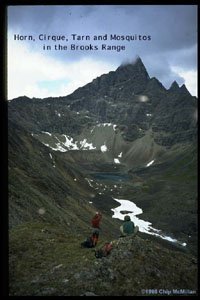
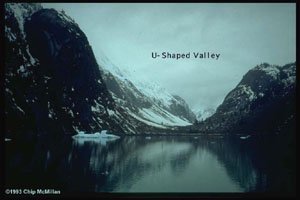
The Brooks Range photo above to the left shows several geologic features caused by glaciers. Glaciers can gradually scour or carve back into a mountain face. If this happens on three sides of a mountain, a sharp horn is left in the middle. A cirque is typically left at the base of the mountain, like someone used a giant ice cream scoop to scoop out a part. You can see a cirque in this photo from the Brooks Range. You can also see a tarn in this photo. It is the little lake at the base of the cirque. Tarns commonly occur with cirques. The fuzzy images are only mosquitoes flying in front of the photographer’s camera lens.
The photo above to the right shows a valley with a distinct u-shape. Any time scientists see a valley with a u-shape to it, they can comfortably guess that it was carved by a glacier. Rivers tend to give v-shapes to valleys, but glaciers give u-shapes to valleys.
Climate
How can glaciers be used to obtain information on long-term climate change?
Snow is porous with lots of air pockets. Everything that was in the atmosphere when it snowed will be trapped and buried under more snow instead of getting washed away by rain.
So What’s in the Atmosphere?
- Trace Gasses
- Volcanic Ash
- Pollen
- Dust
Air bubbles are trapped as porous snow becomes firn. As snow changes to glacier ice, there is more and more ice and less and less pore space.
When glacier ice finally forms, the pore spaces are closed off. All of the things listed above are trapped in the air bubbles. Each pore contains a trapped sample of the atmosphere.
The trapped air is under pressure. That is why a popping sound can be heard on many glaciers; the sound is made as pressurized air escapes from the ice. If you put a piece of glacier ice into a glass of water, the glass might explode as the pressurized air blasts out of the melting ice!
Global Warming Versus Ice Ages
In the past million years there have been nine full glacial periods, separated by much shorter interglacials, or warm spells.
- Each glacial period lasted about 100,000 years.
- Each interglacial period lasted about 10,000 years.
- Slow variations in Earth’s orbit, called Milankovitch cycles, effect the vast, slow changes in ice sheets, glaciers, and sea level.
- The most recent great ice age existed some 18,000 years ago and buried over 30% of the world’s land surface under thick ice and snow.
Today, humans burn hydrocarbon fuels releasing excessive carbon dioxide in the atmosphere and creating the greenhouse effect which can cause more melting of snow. The Earth’s atmosphere traps solar radiation because of gases present such as carbon dioxide, water vapor, and methane. Those gases allow sunlight to pass through but absorb the heat radiated back from the Earth’s surface. Scientists are examining possible relationships between glacial melting and rise in sea levels in order to determine how strong or long-lasting the greenhouse effect may become. If the greenhouse effect increases, Earth may undergo serious global warming.

Our world’s climate is warmer now than at any other time since 6,000 B.C., the “Thermal Maximum,” but geologists say firmly that the Ice Age is still with us; we are only living in a slightly warmer spell of it. To support this, they point out that:
- The entire Arctic Ocean is covered with ice.
- Huge domes of ice lie atop Antarctica and Greenland.
- Glacial rivers of ice in Canada, Alaska, and even on mountains at the Equator help regulate Earth’s weather.
We consider our time in history to be “normal” in terms of temperature but, if we consider the vast cycles which effected the past and will effect the future, and also add humankind’s influence into that equation, our time in history may not be “normal.”
Ice Age: Will the great continental ice sheets begin growing again under the unavoidable Milankovitch cycles?
Global Warming: Will human influence cause the greenhouse effect to delay the natural planetary cycle and bring an age of “global warming?”
Satellite Imagery Aids Scientists in Glacier Study
Black Rapids Glacier: Dr. Craig Lingle, a glaciologist of the Geophysical Institute, University of Alaska Fairbanks, has performed extensive research on Black Rapids Glacier, Alaska. His research tools include use of satellite imagery.
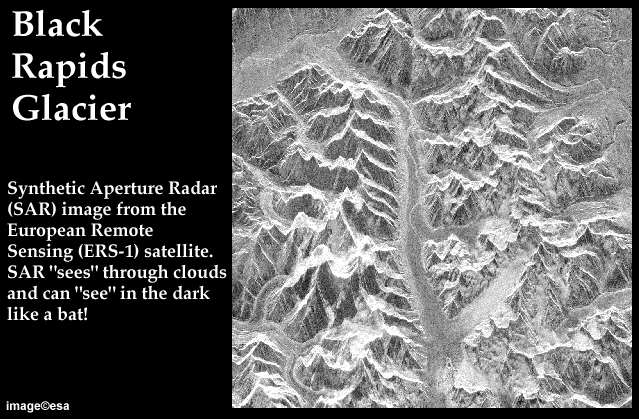
Bering Glacier: the largest glacier in North America descends 190 km from high in the Chugach-St. Elias Mountains to a lake filled with icebergs on the south-central coast of Alaska. Dr. Lingle and others used satellite imagery to study a surge of Bering Glacier.
Bering Glacier Surge: Over 200 surge-type glaciers identified in North America are located in the high, heavily ice-covered mountains of southern Alaska and the Yukon Territory.
Near its terminus, Bering Glacier spreads out 47 km. This glacier is known to have been surging in cycles this century, approximately every 20 years. A major surge began during spring 1993, after a 26 year quiet period.
Crevasses on Bering Glacier Near the Grindle Hills
Extensive fresh crevassing and bulging of the glacier surface were discovered by scientists while flying over the glacier to reach remote camps for field work.
Glaciers are seen through clouds and darkness.
Usually the coastal mountains and glaciers of Alaska are obscured by cloudy weather. For the first time, regular repeated measurements of a surging glacier have been made with satellite imagery through clouds and winter darkness. James Roush, a geology graduate of the University of Alaska Fairbanks, observed the progress of the Bering Glacier surge with satellite synthetic aperture radar (SAR) images received at the Alaska Satellite Facility (ASF). These images were from the European Remote Sensing satellite (ERS-1).
A sequence of images was terrain-corrected.
Terrain-correction includes geocoding and co-registration which means the pixels in the images are referenced to absolute geographic coordinates such as latitude-longitude or universal transverse mercator, i.e. UTM. A pixel is the smallest image-forming unit of a video display.
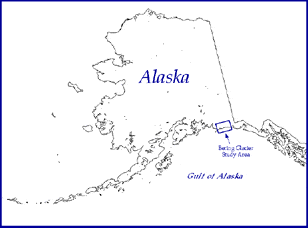
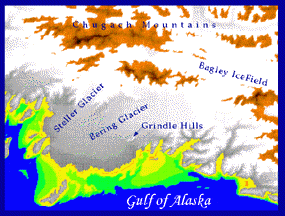

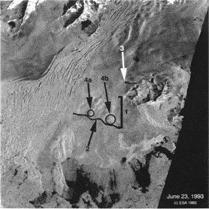
Why do Scientists Study Glaciers?
Vocabulary Plus!
glacial period
interglacial
Milankovitch cycles
SAR
ERS-1
ASF
glaciologist
Bering Glacier
Black Rapids Glacier
Review Questions
(some of the answers may come from the vocabulary list)
- Name one thing you can find out by studying glaciers.
- As the ice compacts, is there more/less (circle one) pore space?
- Glaciers sometimes make popping sounds. Why?
- What is another big word for “warm spells”?
- How long was each interglacial period?
- 18,000 years ago, there was an ice age. How much (%) of the world’s land surface was covered under thick ice?
- Dr. Craig Lingle likes to study glaciers. What kind of scientist is he?
- What is the largest glacier in North America?
- What did James Roush and Dr. Craig Lingle use in order to look at glaciers from space?
Brain Challenge!
Do you think there will be an Ice Age or Global Warming in the next 100 years? Why? (Don’t worry, there is no wrong answer!)
Exercise: Why Study?
Circle the items below that are in the Earth’s atmosphere:
A. Pollen
B. Dust
C. Floating marbles
D. Ash from volcanoes
E. Lost homework
F. Gasses
Why or when might the Earth undergo global warming?
Glacier Study: True or False
Decide whether the following statements are true or false.
If false, correct the statement.
Ice rivers in different parts of the world help regulate the Earth’s weather.
An interglacial is the exact center of a glacier.
Very slow changes or variations in the earth’s orbit are known as Milankovitch cycles.
Our climate is colder now than it has ever been before.
The greenhouse effect is caused by the growing demand for fresh garden vegetables all year round.
Why, for the first time, were scientists able to make regular repeated measurements of the surge of Bering Glacier by using SAR satellite imagery?
Project: World Glaciers
Look at a map of the world. See if you can find and point to the areas that currently have much of the Earth’s ice.
Ask your teacher or parent for help, if you need to.
What do these areas have in common with each other?
Would you expect to find large ice masses in central Africa or South America?
Why or why not?
(Courtesy of Glaciers of North America, By S. Ferguson)